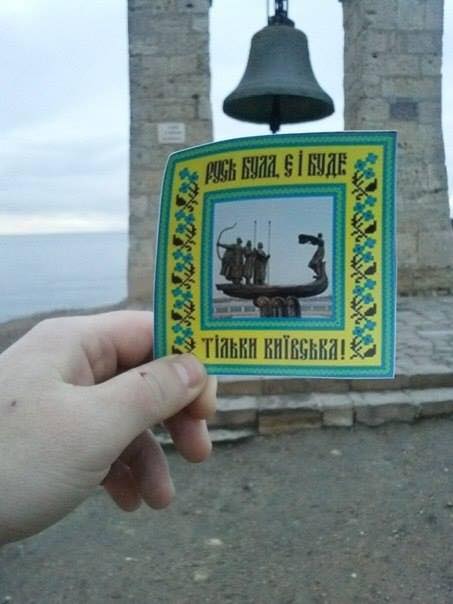On August 23, 1932, a secret circular for the economic division of the secret police (OGPU) of the Crimean Autonomous Soviet Socialist Republic (ASSR) was published "regarding the fight against speculators." Stalin's acolytes were preparing to go to war against Crimea’s many bazaars, the traditional marketplaces where food and goods were bought and sold. Suspecting that the bazaars were forums for Kulaks (the so-called wealthy farmers who were said to resist collectivization) and counter-revolutionary activity, this circular "with the aim of eradicating speculators and traders" instructed the OGPU to conduct extremely tight monitoring of them so that the state could gather evidence for "group arrests on [both] a mass, [as well as] a limited scale." [1] Decrees like this ensured that the Holodomor which was sweeping Ukraine into submission would also sweep Crimea.
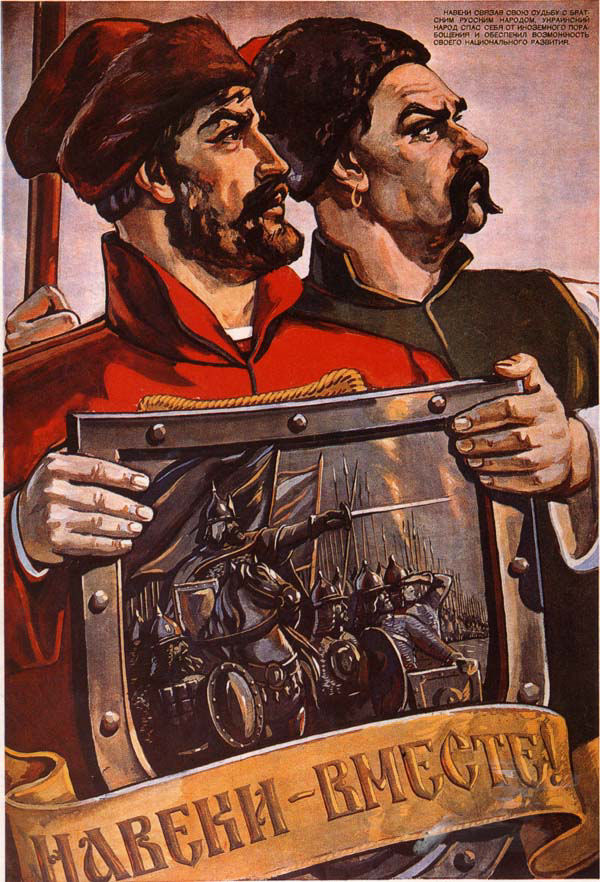
The pretext for this little discussed genocide of the Crimean Tatars in the 1930s was part of Stalin's reaction to the policies and ideas promoted by Veli Ibrahimov, the nominal leader of the Crimean ASSR until 1928. Through the mid-1920s Ibrahimov, himself a Tatar, had promoted a policy program similar to Ukrainization in that he had allowed a flowering of Tatar language and culture so that Communist Party rule (in local terms, his rule) over the Tatars could be consolidated. In 1927 Ibrahimov wanted to extend his power by openly enticing Crimean Tatars to settle in the north of the Crimean peninsula and reclaim it as Tatar country. But this directly contradicted Stalin's plans for the same area. Stalin originally wanted to forcibly deport Belarusian Jews and resettle them in the Crimea (this plan, which itself would have been an act of genocide, was later cancelled). For his "opposition" to Stalin, Ibrahimov was arrested and on May 8 1928 was executed after a show trial in which he was convicted of "Bourgeois Nationalism." [2]
What followed next was a devastating tragedy for the inhabitants of Crimea. Local Communist Party elements and intelligentsia suspected of harboring "Ibrahimovism" were rooted out and liquidated. This was followed by the mass deportation of Tatars to Siberia on the pretext of eliminating Kulaks. According to one Russian eyewitness:
"Whole villages of Crimean peasants were liquidated. Thousands of people were herded behind the barbed wire of deportation camps. People who had grown up in a mild, southern climate and who had never before left their native mountains and sea coast were transplanted to the taiga and tundra and began to die off even during the first stages. This was not the application of mass measures, but the physical destruction, the merciless and senseless destruction of a whole people." [3]
Against the backdrop of "combating bourgeois nationalism," collective farming was introduced. But with the best farmers already gone, having been condemned as Kulaks, famine erupted across the Crimean Peninsula. Between this genocide, and another famine that had struck Crimea in 1921, "half the ethnic [Tatar] population had been killed, deported, or fled," according to one estimate. [4]
By no means was this the first or last blow against the Tatars. By 1938, Tatar literature had been banned and the Tatar alphabet was given a Cyrillic script. Soviet planners wanted to create a thoroughly Sovietised Crimea. In practice, this amounted to establishing Russians as the largest ethnic group on the peninsula. This was accomplished by numerous acts of bloodshed, most infamously, the deportation of 180-200,000 Crimean Tatars in 1944 under the pretext of collaboration with Nazy Germany in WWII. [5] By 1945 the Soviets had so thoroughly subdued the Crimean Tatar population that they felt there was no more need for a distinct Crimean ASSR. Instead Stalin reduced the status of the Crimean Peninsula from an autonomous republic to that of a mere Oblast, or province, of the Russian Soviet Federal Socialist Republic, RSFSR, in 1945.
Underlying today's crisis of Russia’s annexation of Crimea is a deeply complex history of competing claims. In 1954 the Crimea Oblast was transferred to the Ukrainian SSR as a means for Moscow to strengthen its control over Ukraine. Theories that Crimea was simply a "gift" to commemorate the 300th anniversary of the Treaty of Pereyaslav is post-hoc Soviet propaganda. In 2008 in an interview on German TV, Putin conceded that the Crimean peninsula along with the borders with Ukraine were not in dispute, yet that is not the narrative being promoted by the Kremlin now. This spring a bill will be rammed through the Russian Duma which will officially designate Crimea’s 1954 transfer to Ukraine as "illegal." According to the Federation Council Speaker, Valentina Matviyenko, this bill will ensure "historic and legal justice" because "we want to document the injustice done to Crimea and Sevastopol. It will be like a historic fact and a historic document." Her words echo the current Kremlin narrative: that Crimea has always belonged to Russia, and, in fact holds a sacred place in Russia’s history and identity.
Putin put it this way in his speech to the Russian Federal Assembly last December:
"[T]he peninsula is of strategic importance for Russia as the spiritual source of the development of a multifaceted but solid Russian nation and a centralised Russian state. It was in Crimea, in the ancient city of Chersonesus or Korsun, as ancient Russian chroniclers called it, that Grand Prince Vladimir was baptised before bringing Christianity to Rus. ... [T]his allows us to say that Crimea, the ancient Korsun or Chersonesus, and Sevastopol have invaluable civilisational and even sacral importance for Russia, like the Temple Mount in Jerusalem for the followers of Islam and Judaism." [emph. added] [6]
Perhaps it might seem inconvenient to point out that the home of Grand Prince Vladimir (Wolodymyr in Ukrainian) was actually Kyiv. It is also important to understand that we're dealing with a time period when the concepts of Russia or Ukraine did not exist as we know them today. [7] The Russia that we know today evolved out of the medieval state of the Grand Duchy of Moscow, and if there is such a thing as a founding father of the Grand Duchy of Moscow, then it would be Grand Prince Daniel, who lived through the late 1200s. (He died in 1303.) By then, the Kyivan-Rus, a somewhat loose federation of Slavic city states bound together by the ties of military and political elites with origins in the fjords of Scandinavia, had already long existed. Crimea in the early medieval period existed only on the periphery of the Kyivan-Rus. In the 900s most of Crimea belonged to the Khazar Empire with the exception of the far south and around Korsun, which was under the influence of the Byzantine Empire owing to the heritage of Ancient Greek settlers. Korsun was also home to a small Gothic enclave (centered around the fortress settlement of Mangup), and in the late autumn of 962, the Crimean Goths appealed to the ruler of Kyiv Prince Sviatoslav I to come to their aid against punitive raids conducted by former subjects of the Khazar empire which the decaying state had lost control of. [8] This was a call Sviatoslav responded to, according to the Primary Chronicle,
in 965;
"When they [The Khazars] heard of his approach, they went out to meet him with their Prince, the Kagan, and the armies came to blows. When the battle thus took place, Sviatoslav defeated the Khazars and took their city of Bela Vezha [Sarkel]." [9]
Subsequent military campaigns by his son, Grand Prince Vladimir (Wolodymyr), helped bring more of Crimea into the fold of the Kyivan-Rus, during which in 988 he was symbolically converted to Christianity at Korsun so that he could marry the sister of the Byzantine emperor, Basil II.
Crimea remained in the hands of the Kyivan-Rus and the Byzantines until the 1200s when both were fractured and dissolved under the weight of other growing empires. For the peoples of the Kyivan-Rus, it was the sudden presence of the Mongols which came as a rude and unwelcome shock. On May 31 1223, a Kyivan army was routed at the Battle of Kalka. Between 1236-7 Batu Khan, the grandson of Genghis Khan, burnt Moscow and annihilated the city of Ryazan. In 1238 he destroyed the Principality of Vladimir before moving to the South and West. In the same year Batu Khan overturned Kyivan-Rus rule in Crimea before sacking Kyiv in 1240.
Many in Russia see this as the beginning of the "Mongol Yoke," a time of enslavement, ritual humiliation and excessive tribute. Yet the Mongols also gave the Muscovites a model of statehood they would adopt, which allowed their rise to prominence among the East European Slavs by giving them concessions in return for high tribute. The Mongols changed the Crimean Peninsula permanently too, as the horsemen of Batu Khan settled there and in the process assimilated much of the peninsula's inhabitants, such as the Crimean Goths [10]. These are the ancestors of the Crimean Tatars. They would rise to become the majority ethnic group there. [11]
The "Golden Horde," the western-most region of the Mongolian Empire, disintegrated in the late 1400s. The Crimean Tatars then fell into the sphere of influence of another rising imperial power to the south, the Ottoman Empire. In 1478 the “Crimean Khanate” became a vassal state to the Ottoman government headed by the Sultanate in Constantinople, often called the Sublime Porte or simply the Porte (Arabic باب عالی). It remained as such for almost 300 years, leaving a legacy of Islam as the dominant Tatar religion, still dominant today.
The first Russian foray into the Crimean Peninsula began as a result of the 1735-39 Austro-Russian-Ottoman War. Responding to raiding parties conducted by the Crimean Tatars in the Khanate, on June 17, 1736, a Russian army led by a German, Burkhard Christoph von Münnich, began a brief occupation of the fortress-city of Bakhchisaray, the capital of the Khanate. In 1737 another Russian army under the Irish-born Count Pyotr Petrovich Lacy invaded Crimea. In both cases the armies had to retreat from Crimea, having succumbed to disease and isolation more than combat.
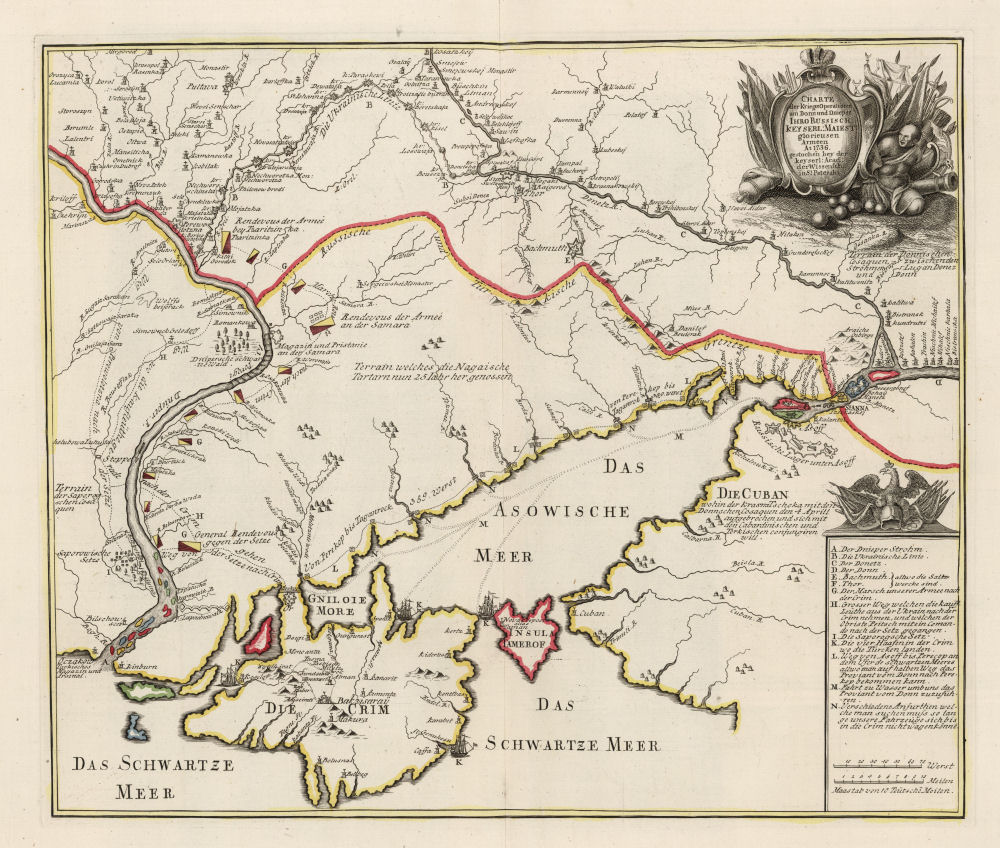
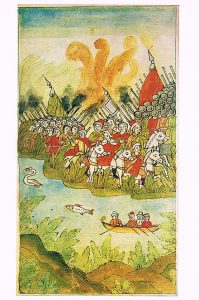
(Here it’s worth noting that during the Russo-Ottoman War of 1686-1700, the Russians did attempt to launch a pair of military campaigns to isolate the Crimean Peninsula. Both campaigns however ended in disaster even before Crimea had been reached. The Russians were confounded by a Tatar defensive strategy that in modern terms would be called a “scorched earth policy.” The image on the right is taken from an 18th century manuscript titled “The History of Peter I” which depicts a Russian army headed by the Russian aristocrat, Vasily Vasilyevich Golitsyn, in retreat following the Samara. Behind them is the Tatar countryside in flames.)
Full Russian occupation of Crimea did not begin until after the Treaty of Küçük-Kaynarca in 1774, the conclusion to another war between the Ottomans and the Russians when the Ottomans had found themselves on the losing side. This treaty tore the Crimean Khanate away from the Ottoman Empire and left the peninsula politically fractured with frequent Tatar rebellion against a new puppet regime headed by Khan Sahin Giray, put in place by Empress Catherine. These rebellions prompted the full Russian annexation of Crimea. Keeping the rebellions under control and Khan Sahin Giray as ruler of Crimea required Russian military intervention, so it was argued. On August 3 1782 Grigory Potemkin wrote a letter to Empress Catherine advising that Russian armies should stay in Crimea for as long as it was needed to keep the new status quo. [12] Empress Catherine consented, and by early 1783 she had posted 50,000 soldiers to the peninsula. [13] This was the beginning of a permanent Russian military presence. The annexation was confirmed with her signature to a manifesto proclaimed on April 8 (OS) 1783. However, according to the Russian version of events, as recorded by Count Alexander Bezborodko, advisor to Empress Catherine:
"The Porte has not kept good faith from the very beginning. Their primary goal has been to deprive the Crimeans of independence. They banished the legal khan and replaced him with the thief Devlet Giray. They consistently refused to evacuate the Taman. They made numerous perfidious attempts to introduce rebellion in the Crimea against the legitimate Khan Sahin Giray. All of these efforts did not bring us to declare war…. The Porte never ceased to drink in each drop of revolt among the Tatars…. Our only wish has been to bring peace to Crimea…and we were finally forced by the Turks to annex the area." [14]
This view was far from the reality. As Alan Fisher notes, “the real opposition to the requirements of the Treaty of Küçük-Kaynarca had never been in Istanbul; it had been within the Crimea. Sahin Giray and his policies of change under the direct influence and control of the Russians had left the Crimean [Tatar] elite little choice than to flee or provide opposition at home. The independence of the Crimea during this period was no more than a sham perpetrated and perpetuated by the force of Russian arms. It was a transitory period between Ottoman suzerainty and Russian suzerainty.” In other words there is little to suggest that the Porte played a direct role in the Crimean revolts. [15]
Aside from helping to solidify the annexation of Crimea, the Treaty of Küçük-Kaynarca had another consequence which was to ultimately impact the Crimean Peninsula. This Treaty gave the Russians the basis for beginning to proclaim they were protecting the rights of their population of Orthodox Christians within in the Holy Lands of the Middle East controlled by the Ottomans. In 1852 this directly contrasted with Napoleon III's wishes to exercise protection of Roman Catholics in the same Holy Lands. These two competing wishes helped exacerbate possibly one of the most bizarre reasons for turning a religious conflict into an actual war.
In 1847 a Silver Star marking the place where Jesus was allegedly born in the Church of the Nativity was stolen. By 1852 physical fights broke out between Roman Catholic and Orthodox monks over what should replace it, another Silver star (which suited the Orthodox monks), or a Latin inscription (which suited the Roman Catholic monks). Both "protectionist" France and "protectionist" Russia took obvious sides. The Sublime Porte in Constantinople sided with the French over the Russians (due to France sending a warship to the Dardanelles) which violated Russian "protectionist claims." In response Russia decided to invade the Ottoman provinces of Moldavia and Wallachia in 1853. Because of the fears that Russian expansionism threatened the interests of France and the fears that Russia could cut off access to Britain’s colonies in the Far East, both intervened in March 1854 and found themselves as unusual allies with one another and the Ottomans. Thus another Russo-Ottoman War turned into what is referred to today as the Crimean War; that is, after the British and French campaign undertook to knock out the Russian Black Sea naval base at Sevastopol by landing on the peninsula.
The 1853-55 Crimean War holds a peculiar place in British historiography, in part because of the nature of that conflict, which lies in between a way of fighting Napoleon Bonaparte would have been familiar with and a way of fighting more reminiscent of the Western front during WWI. The British in particular like to fill themselves with romantic tales of "The Alma," "Balaklava," the "Great Redan," "Sevastopol," the legend of "Florence Nightingale," and so on. But whilst the British feast themselves on 19th century military adventurism, they often miss what happened to the local populace as a result of the conflict.
In late September 1854 there was discussion amongst the British of creating an independent post-war Crimea under local Tatar rule to be guaranteed by Britain, France and Austria (a position argued by both Lord Clarendon and Lord Stratford) or returning Crimea to the Ottoman Empire. In the end both these proposals were discarded, reasoning that a Crimea out of Russian hands would only store up future trouble with Russia who would remain intent on reclaiming it. [16] Had either of these proposals been followed through, then this might well be a different post. However, what came to pass post-war was a state of harsh repression against the Crimean Tatars enacted by Tsar Alexander II in the 1860s because of their “traitorous” affinities to the Ottoman Empire. According to one estimate, in order to escape Alexander's repression, 181,177 Crimean Tatars emigrated to the Ottoman Empire, and after the annexation of Crimea in 1783, between 1785-1788 about 100,000 Crimean Tatars left their homeland. [17]
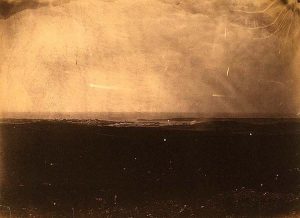
(Donovan - “Heights of Alma.” A somewhat modern rendition of what was a popular late 1800s song commemorating a British victory of the Battle of the Alma in the Crimean War of 1853-5. Because of the romantic way it was depicted at the time, Alma became a popular British girls name in the late 1800s. But the real battle wasn’t quite the “Glorious September 20” depiction you hear in this song. Whilst Lord Raglan did achieve a victory, he squandered an opportunity to press any advantage he gained as a result of the battle as the Russians retreated to Sevastopol.)
(Documentary on the Crimean War. For those who want a further introduction to the Crimean War of 1853-5, there is a documentary series (made in the early 1990s I should note) for British TV currently on youtube. Here is Part 2 & Part 3.)
The transformation of Crimea continues to this day. Visible traces of the peoples that inhabited the Crimea Peninsula before the Tatars have all but disappeared. Stalin did his share to contribute to that disappearance. On May 29, 1944 Beria sent a note to Stalin stating that within the Crimea peninsula there were a multitude of “Anti-Soviet elements” among which were 14,300 Greeks, 9,919 Armenians and 12,075 Bulgarians. Stalin’s reply, a State Resolution on June 2, 1944, ordered a deportation of 37,000 Greeks, Armenians and Bulgarians. Even those among these minority groups who had served in the Red Army did not escape deportation. [18]
The Crimean Tatars have been deeply affected by the events of the 1700s to the present, having been turned from a majority population into today's small minority. Because of these experiences, it is not surprising that they continue to fear the next moves of Putin, who seems determined to silence their voices
, as is evidenced by the recent forced closure of their TV stations as well as his acolytes forbidding the commemoration of the anniversary of the 1944 deportations. Instead, a new history of Crimea is being rewritten, one in which Stalin is absurdly glorified and books about the Holodomor are being confiscated. History is being ignored and deliberately forgotten. It is perhaps for this very reason that Crimea's history is worth remembering.
![]()
Notes
[1] J Bednarek et al., "Poland and Ukraine in the 1930’s – 1940’s, Unknown Documents from the Archives of the Secret Services. Holodomor The Great Famine in Ukraine. 1932–1933," No 51, p174-79.
[2] For details, see B Williams, "The Crimean Tatars: The Diaspora Experience and the Forging of a Nation," p365-74.
[3] Quoted in Williams, Ibid., p367.
[4] J Minahan, "The Former Soviet Union's Diverse Peoples: A Reference Sourcebook," p164.
[5] This wasn’t the only mass deportation carried out by Stalin on the basis of this claim, see, for example, my post on the Caucasus.
[6] V Putin, "Presidential Address to the Federal Assembly. December 4, 2014."
[7] Medieval history is arguably easier to cloud than modern history for purposes such as propaganda because of the fact that primary source material is more fragmentary and limited. For this reason, medieval history rests more on reinterpretation of what primary materials there is than modern history, which can call upon a wider variety of governmental (archival) documents, newspaper accounts, diary entries, recorded eyewitness statements, as well as the addition of photography, recorded footage etc. to give a fuller account of a time and place. There is clearly a value in watching out for propaganda concerning the medieval era. One of the particular pains for any medievalist surely ought to be the curse of "Retrospective-history" where ideas that do not belong to a time and place are nonetheless deliberately implanted into said time and place with the presumption that the peoples who lived in said time and place thought in the same way as those of the modern world. Calling the Kyivan-Rus "Russia" (as the title of citation [8] does) when "Russia" as the concept we recognise today did not exist back in the medieval world would be an example of this. An analogy for Western Europe might be that of Charlemagne, where strains of retrospective-history often place him as being either French or German in modern senses that he wouldn't quite have understood. The closest extant language to the one he spoke is Flemish.
For details on how Kyivan-Rus history has been distorted, see Y Dashkevych "How Moscow hijacked the history of Kyivan Rus."
[8] See S Cross & O Sherbowitz-Wetzor (trans & eds), "The Russian Primary Chronicle," p240.
[9] S Cross & O Sherbowitz-Wetzor, Ibid., p84. It has been argued (See [8]) that this mention of Sviatoslav's campaign actually does not refer to any military action in Crimea, although it is worth noting that the chronology of Sviatoslav's Crimea campaign remains unclear.
[10] B Williams, Ibid., p25. As Williams points out, understanding this helps to understand why some Crimean Tatars describe themselves as being the descendants of the Circassians, Goths, Ancient Greeks, Italians and Armenians who had previously settled in Crimea before the arrival of the Mongols. See, for example, E Gözaydin, "Kirim: Kirim Türklerinin Yerlesme ve Göçmeleri," p30.
[11] A Illarionov, "The ethnic composition of the population of Crimea for three centuries." This includes an interesting set of graphics relating to the proportional decline of the Crimean Tatar population between the 1760s and 2000s.
[12] D Smith (eds and trans), “Love and Conquest: Personal Correspondence of Catherine the Great and Prince Grigory Potemkin,” p121.
[13] A Özer, “The Ottoman-Russian relations between the years 1774-1787”, p61.
[14] Quoted in A Fisher, “The Crimean Tatars: Studies of Nationalities in the USSR,” p69.
[15] A Fisher, Ibid., p69.
[16] T Royle, “Crimea: The Great Crimean War. 1854-56,” p207. Whilst Royle’s book offers an excellent narrative of the conflict, he fails to discuss the state of the Crimean peninsula post-war, instead placing the conflict in a context with regards to the origins of WW1 and the technological developments leading up to WW1. Other than this citation the Crimean Tatars barely get a mention in his book.
[17] For figures see http://www.iccrimea.org/scholarly/jankowski.html.
[18] R Gellately, "Lenin, Stalin and Hitler: The Age of Social Catastrophe," p515-16. For Stalin's reply, see D Koenker and R Bachman (Eds.), "Revelations from the Russian Archives," No 104, p209-10.



